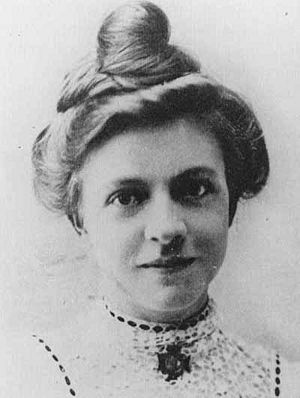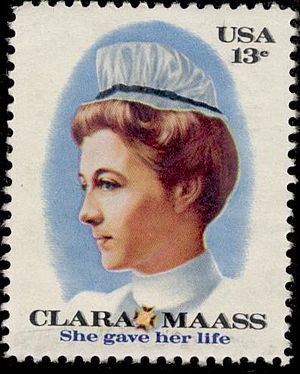Clara Maass facts for kids
Clara Louise Maass (born June 28, 1876 – died August 24, 1901) was an American nurse. She is remembered for volunteering in medical experiments to study yellow fever. Sadly, she died from the disease during these studies.
Contents
Early Life and Nursing Career
Clara Louise Maass was born in East Orange, New Jersey. Her parents, Hedwig and Robert Maass, were immigrants from Germany. Clara was the oldest of ten children in a religious Lutheran family. Her family was not wealthy. To help out, Clara worked as a "mother's helper" while finishing high school.
At age 15, she started working at the Network Orphan Asylum. Two years later, at 17, Maass began nursing school. She was inspired by the famous nurse Florence Nightingale. In 1895, she was among the first to graduate from Newark German Hospital's Christina Trefz Training School for Nurses. By 1898, she became a head nurse. She was known for being very hardworking and dedicated to her job.
Serving in the Army
In April 1898, during the Spanish–American War, Clara Maass volunteered as a nurse for the United States Army. The Army Nurse Corps did not exist yet. She was sent home briefly after getting dengue fever.
She then served with the Seventh U.S. Army Corps from October 1898 to February 1899. She worked in Jacksonville, Florida; Savannah, Georgia; and Santiago, Cuba. She was discharged in 1899. However, she volunteered again to serve in the Philippines from November 1899 to mid-1900.
During her time with the military, she mostly cared for soldiers with illnesses. These included typhoid, malaria, dengue, and yellow fever. She got dengue in Manila and was sent home. She returned to serve after Major General William Gorgas asked for nurses to volunteer in Cuba.
Yellow Fever Studies
Yellow fever was a big problem for soldiers during the Spanish-American War. It caused many deaths, even more than battle wounds.
In October 1900, Maass went back to Cuba. She was called by William Gorgas. He was working with the U.S. Army's Yellow Fever Commission. This group, led by Major Walter Reed, was trying to understand yellow fever. The disease was common in Cuba. One main goal was to find out how it spread. Was it by mosquito bites or by touching contaminated objects?
Volunteering for Science
The commission needed human volunteers. This was because they did not know of any animals that could get yellow fever. Volunteers were told that they might die from the studies. This was one of the first times people were fully informed about risks in experiments. Volunteers were paid $100. They got an extra $100 if they became sick.
In March 1901, Maass volunteered to be bitten by a Culex fasciata mosquito. This mosquito is now called Aedes aegypti. It had fed on yellow fever patients. Clara was the only female and American among 19 volunteers. She believed this would help her be a better nurse. She wanted to understand what it felt like to have the disease.
By this time, researchers were quite sure mosquitoes spread the disease. But they needed more proof. Some volunteers who were bitten did not get sick. Maass kept volunteering for experiments. She sent all the money she earned to her mother.
The Final Experiment
Maass was bitten by mosquitoes in March, May, June, and August of 1901. She came into contact with yellow fever mosquitoes seven times. After her first bite, she got mildly sick. Researchers thought she was not immune. So, they continued their tests with Clara as a live subject.
On August 14, 1901, Maass allowed herself to be bitten by infected mosquitoes again. Researchers hoped this would show she was now immune. Sadly, this was not the case. Maass became very ill with yellow fever on August 18. She died on August 24 at the age of 25. She sensed something was different this time. She wrote a goodbye letter to her mother days before her death.
Her death made the public very sad. It also stopped yellow fever experiments on humans. Because of her contributions, Clara became known as the woman who gave her life for science. Maass was first buried in Havana with military honors. Her body was later moved to Fairmount Cemetery in Newark, New Jersey, in February 1902.
After Maass' death became public, newspapers reported different stories. Some said she only joined the studies for money. Others said she did it for her mother. Her mother was upset by these claims. She felt what happened to her daughter was like murder. Clara's work was not widely known until Leopoldine Guinther, a hospital superintendent, shared her story.
Clara Maass's Legacy
Clara Maass's work helped make the yellow fever vaccine possible. The Cuban government placed a bronze plaque at Las Animas Hospital in Havana. This was the hospital where she died. It honors her sacrifice.
In 1951, on the 50th anniversary of her death, Cuba released a postage stamp in her honor. On June 19, 1952, Newark German Hospital was renamed Clara Maass Memorial Hospital. It is now known as Clara Maass Medical Center. In 1976, on the 100th anniversary of her birth, Maass was honored with a 13¢ United States commemorative stamp. She was the first nurse to be honored with a stamp. She was also the first nurse to have a hospital named after her. In 1976, the American Nurses Association added her to its Nursing Hall of Fame.
The Calendar of Saints of the Lutheran Church honors Maass and British nurse Florence Nightingale. They are celebrated on August 13 as "Renewers of Society."
See also
 In Spanish: Clara Maass para niños
In Spanish: Clara Maass para niños
- Unethical human experimentation in the United States



